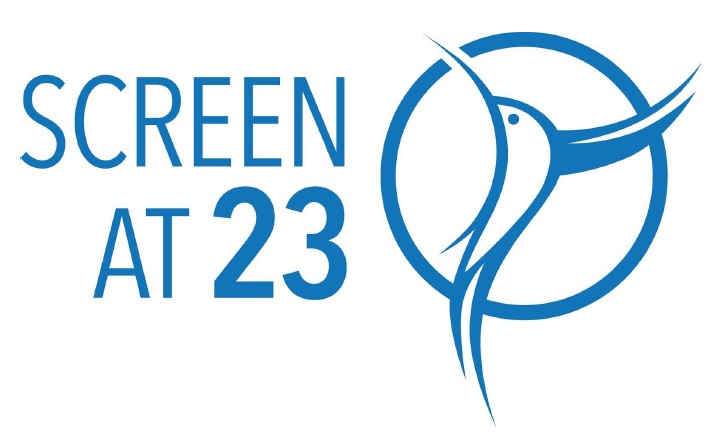
Because equitable testing would reveal hundreds of thousands of cases of prediabetes and diabetes among Asian Americans, allowing them to get the treatment or intervention they need to live healthier, happier lives.
More than half of Asian Americans with type 2 diabetes, and even more
Asian Americans with pre-diabetes, are undiagnosed. To make treatment,
intervention, and even prevention of diabetes possible, we need to first
ensure that it is revealed. We need to call for appropriate screening
practices for Asian Americans. We need to screen at 23.
AADI is leading the "Screen at 23" Campaign as a founding partner of Asian American Native Hawaiian Pacific Islander Diabetes Coalition (AANHPI DC).
Asian Americans Are At Risk For Type 2 Diabetes At A Lower Body Mass Index

The general rule has been that if you have a body mass index below 25, you aren't at risk for diabetes. Research on Asian Americans, however, proves different. The American Diabetes Association, National Institutes of Health, and the Centers for Disease Control have all recently acknowledged that Asian Americans should be screened for diabetes at a lower body mass index, and 23 is that number.
More than half of Asian Americans with type 2 diabetes, and even more with prediabetes, are undiagnosed; there isn't enough awareness among patients and providers of this appropriate guideline. To treat, intervene, and even prevent diabetes, we need to first ensure that it is revealed. That means making doctors and patients aware that a body mass index of 23 is a risk factor to consider for screening diabetes in an Asian American patient.
Know your risk: Screen at 23 using this tool, and talk to your health provider.
If we can make doctors and patients aware of the need to Screen at 23, we can make that happen.
Check out the Resources section for more information including the Screen at 23 package
About The Campaign
"Screen at 23" seeks to do what it says: get every Asian American patient with a body mass index of 23 or higher screened for diabetes. This requires educating providers who previously might rule out diabetes as a risk factor for an Asian who is "skinny" or "average" in build. It requires educating the public that having a BMI of 23 is not a new definition of "overweight" or "obesity" for Asian Americans, but rather a number to look out for, one that should have individuals thinking about making healthy changes to their diet and incorporating healthy changes to their lifestyle, such as exercising. Above all, the campaign seeks to unmask diabetes and prediabetes in Asian Americans.
Campaign Organizer: NCAPIP
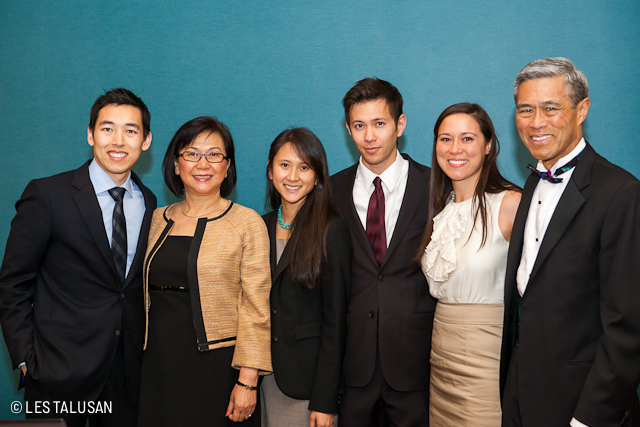
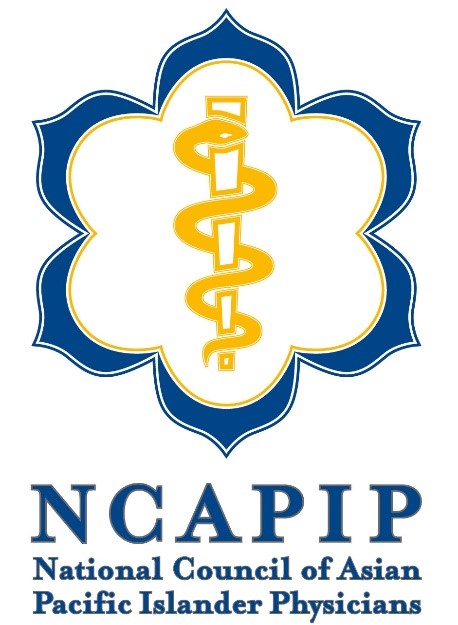
The National Council of Asian Pacific Islander Physicians (NCAPIP) is a nonprofit organization of physicians working towards eliminating health disparities in Asian American, Native Hawaiian, and Pacific Islander (AANHPI) patients. NCAPIP members are comprised of leaders in national, state, and local physician organizations and medical groups. They are physicians practicing across a wide variety of settings from small and solo private practices, medical groups, community health centers, private and public hospitals, academic health centers, and state and local health departments. Their experience across all levels of medicine, care, and knowledge of the population makes NCAPIP an organization uniquely capable to advocate for the health of AANHPIs.
NCAPIP acts as a bridge between physicians, patients, and health policy makers.
Key Partners
In 2011, NCAPIP organized diabetes symposium in Hawaii with the support of the American Diabetes Association and Joslin Diabetes Center. This led to the formation of the AANHPI Diabetes Coalition, a coalition of organizations and individuals dedicated to alleviating and eliminating the diabetes disparities in AANHPI communities. NCAPIP has coordinated the Coalition since 2011, pushed the Coalition's agenda forward, and created the "Screen at 23" campaign to raise awareness of the need to screen Asian Americans for diabetes at a lower body mass index.
Leaders within the AANHPI Diabetes Coalition are some of the foremost experts in diabetes research among AANHPI, and their research has been the foundation that the ADA guidelines are based on. The "Screen at 23" campaign is a reflection of their work.


The Asian American Diabetes Initiative (AADI) at Joslin Diabetes Center, (affiliated with Harvard Medical School) is a founding partner of the AANPI Diabetes Coalition. AADI conducts and publishes some of the leading research on diabetes among AANHPI populations, including the foundational studies that led to the formation of the "Screen at 23" campaign. Joslin AADI is committed to turning good research into good action, and has supported the Coalition with funding, guidance, and leadership over the past four years.


The American Diabetes Association (ADA) is the world's largest organization dedicated to eliminating diabetes. In January 2015, the Association changed its Standards of Medical Care in Diabetes to reflect the need to screen Asian Americans at a body mass index of 23. The Association has focused on diabetes among minority populations through efforts such as our Diabetes Disparities Action Councils which focuses on advocating for the needs of higher risk communities, and in 2011 helped form the AANHPI Diabetes Coalition to push forward initiatives focused on diabetes in AANHPIs. The Association has provided guidance and crucial funding support to the AANHPI Diabetes Coalition, including funding the "Screen at 23" campaign website.
The Association is committed to addressing diabetes disparities and advocating for health equity.
Resources
Screen at 23 Package - The details are inside: the science, significance, and the impact we can have
What's Your Number? Asian BMI Calculator (Courtesy of Joslin AADI)
ADA Standards Of Medical Care In Diabetes--2015 Abridged For Primary Care Providers Published by the American Diabetes Association in 2015. The newly revised standards, based on scientific evidence, highlight a body mass index of 23 as a risk factor for diabetes among Asian Americans.
BMI Cut Points To Identify At-Risk Asian Americans For Type 2 Diabetes Screening (Hsu, Et. Al)
Published in Diabetes Care, 2015
This paper informed the ADA's decision to recommend BMI 23 for screening diabetes in Asian Americans.
From the ADA's associated press release:
Alexandria, Virginia
December 23, 2014
The American Diabetes Association is lowering the Body Mass Index (BMI) cut point at which it recommends screening Asian Americans for type 2 diabetes, aligning its guidelines with evidence that many Asian Americans develop the disease at lower BMI levels than the population at large, according to a position statement being published in the January issue of Diabetes Care
Impact Of Lowering BMI Cut Points As Recommended In The Revised American Diabetes Association Standards Of Medical Care In Diabetesd2015 On Diabetes Screening In Asian Americans (Hsia Et Al.)
Published in Diabetes Care, 2015
Early identification of these conditions may be beneficial for primary and secondary prevention in this unique population that develops prediabetes and diabetes at lower BMI levels.
Prevalence Of And Trends In Diabetes Among Adults In The United States, 1988-2012 (Menke, Et Al.)
Published in JAMA, 2015
To our knowledge, our study provides the first estimates of the prevalence of total diabetes, undiagnosed diabetes, and prediabetes among Asian participants in the United States. More than half of non-Hispanic Asian participants had not been previously
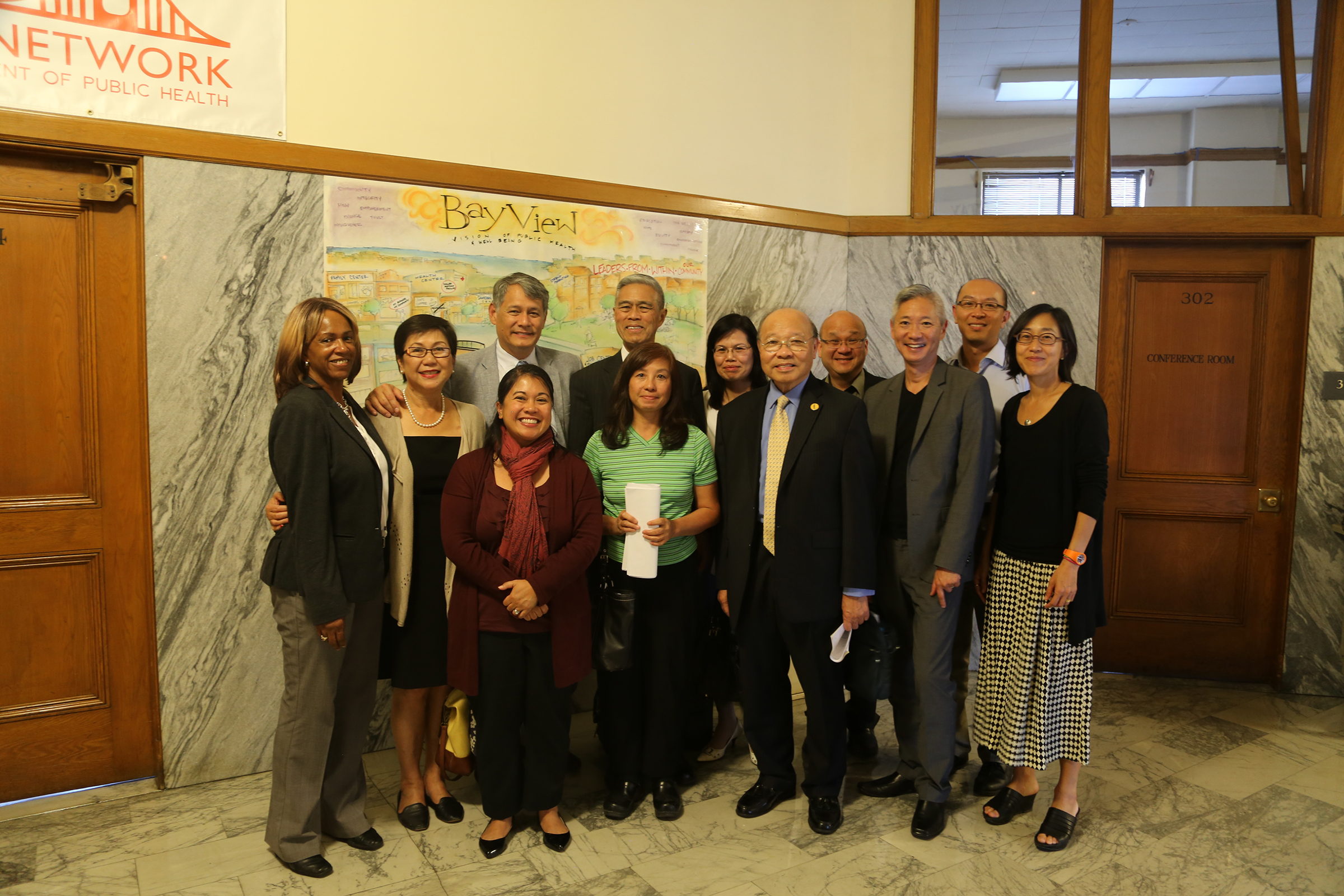
From the San Francisco Department of Public Health press statement:
[On October 21, 2015] the San Francisco Department of Health, the San Francisco Health Commission voted unanimously to support a campaign to unmask the hundreds of thousands of hidden cases of diabetes among Asian Americans. Organized by the National Council of Asian Pacific Islander Physicians (NCAPIP) in partnership with the Asian American, Native Hawaiian, and Pacific Islander Diabetes Coalition, the campaign's goal is to screen Asian Americans with a body mass index of 23 for type 2 diabetes. The passing of the resolution makes San Francisco the first city and county to encourage the adoption of these appropriate screening guidelines throughout its citywide healthcare system.
Read the SF Health Commission's Resolution
Download
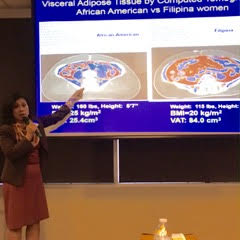
Published in Diabetes Care, 2015
The BMI cut point for identifying Asian Americans who should be screened for undiagnosed type 2 diabetes should be <25 kg/m2, and ‡23 kg/m2 may be the most practical.
Selected as one of the 9 most noteworthy articles published or accepted in Diabetes Care, and featured in the "Best of Care" at the 2015 American Diabetes Association's Scientific Sessions in Boston.

Where Diabetes Is Concerned, Hawaii Isn't THAT Healthy
12/16/05 in West Hawaii Today, Dr. Wilfred Fujimoto, a pioneer researcher in diabetes among Asian Americans and a founding member of the AANHPI Diabetes Coalition, wrote that while Hawaii was just ranked "the healthiest state in the US" – including low overall obesity rates – that assertion is based on obesity data that "may be wrong", especially as applied to Asians who comprise over 50% of Hawaii's population.
"Asians have the lowest prevalence of obesity yet have higher prevalence of diabetes than blacks, whites and Hispanics," wrote Dr. Fujimoto. "Health care providers must be vigilant about undiagnosed diabetes when they are faced with an Asian patient and remember that they should "'Screen at 23.'"

On Saturday, November 14th 2015, Congresswoman Judy Chu, Dr. George King, and Dr. Ho Tran presented and gave remarks around the Screen at 23 campaign to members of Allied Pacific Independent Practitioners Association. "I urge the AAPI community to encourage family members, friends, and loved ones to get screened and be on alert for BMI number 23," Representative Chu announced.
Download
State Resolutions: Hawaii, California, And Massachusetts
.svg.png)

Hawaii became the first state to "Screen at 23″on March 22, 2016. The Hawaii State Legislature voted to pass Joint Resolution S.R. 23. In Hawaii, where close to half of the population is of Asian American descent, screening at 23 would reveal more than 10,000 additional cases of diabetes and more than 30,000 new cases of prediabetes and allow treatment to begin, interventions occur before damaging associated conditions develop or worsen, or make diabetes prevention possible. To view the Hawaii resolution click here.

California followed the San Francisco and Hawaii resolutions, passing it's own Screen at 23 resolution, SCR 134 by State Senator Dr. Richard Pan, on September 9, 2016. Screening at 23 in California would reveal close to 70,000 additional cases of type 2 diabetes in Asian Americans, and many more cases of prediabetes. To view the resolution click here.

On January 25, 2018, the Commonwealth of Massachusetts passed a Joint Resolution to Screen at 23. Screening at 23 in Massachusetts would reveal over 6,000 additional cases of type 2 diabetes in Asian Americans. View the resolution here.

Washington State passed its Screen at 23 Resolution on April 27, 2019.
To view the resolution in another window, use the “download” link here: download

Illinois passed its Screen at 23 Resolution on November 28 2018 to step up efforts in identifying over 9,000 Asian Americans in the state with diabetes, and many more with prediabetes. To view the resolution, click here.
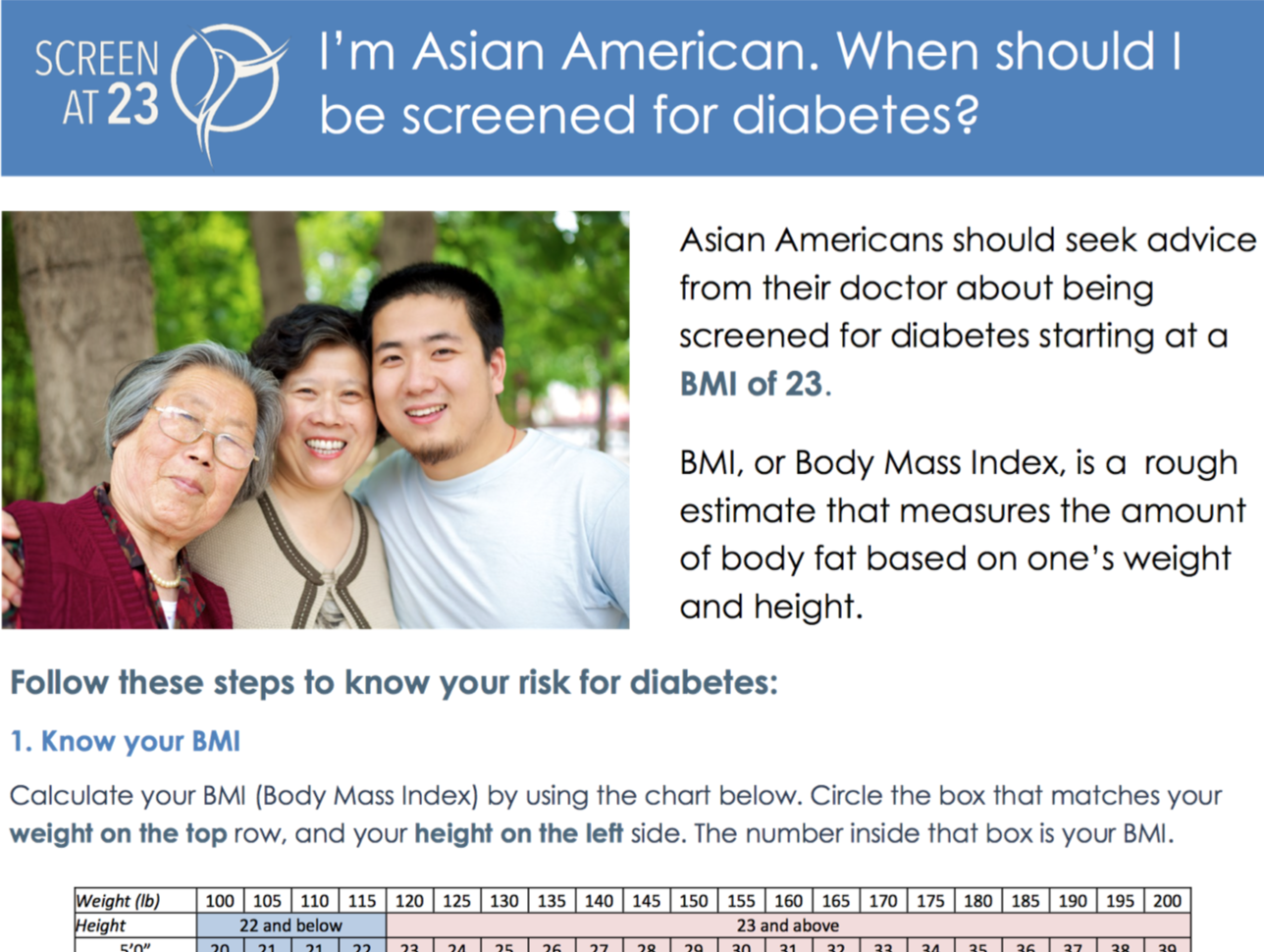
For Asian American patients to understand their risk, get their BMI, and talk to their doctor.
This guide for health providers seeing Asian American patients was reviewed by primary care physicians, researchers at Harvard’s Joslin Diabetes Center, and members of the American Diabetes Association and Centers for Disease Control.
The scope of the campaign in one page.

The 4 Steps to Manage Your Diabetes for Life booklet helps people with diabetes understand, monitor, and manage their diabetes to help them stay healthy. This publication has been reviewed by the National Diabetes Education Program (NDEP) for plain language principles and is available in multiple languages.
English, Chinese, Hindi, Gujarati, Korean, Tagalog
In Moving Pictures: The "Why" Behind Screening At 23 (YouTube)
Click here to watch
This video collaboration between UCSD medical student Brian Nguyen and science YouTuber Armando Hasudungan, in partnership with the AANHPI Diabetes Coalition and the Screen at 23 campaign, breaks down the revised ADA Guidelines (and the science behind them) for screening Asian Americans for type 2 diabetes.
"Asians are 30% more likely to develop diabetes and we need to educate doctors and health care providers on this." – Massachusetts State Senator Jason Lewis

Members of the Joslin Diabetes Center’s Asian American Diabetes
Initiative and the Massachusetts State Legislature

George King addresses legislators, media, and the public about Screen at 23 at the Massachusetts State House on Jan 25, 2018 Read the interview with Dr. George King

Mass. State Representative Tackey Chan
RISE To Avoid, Control, And Reverse Diabetes And Prediabetes In Asian Americans
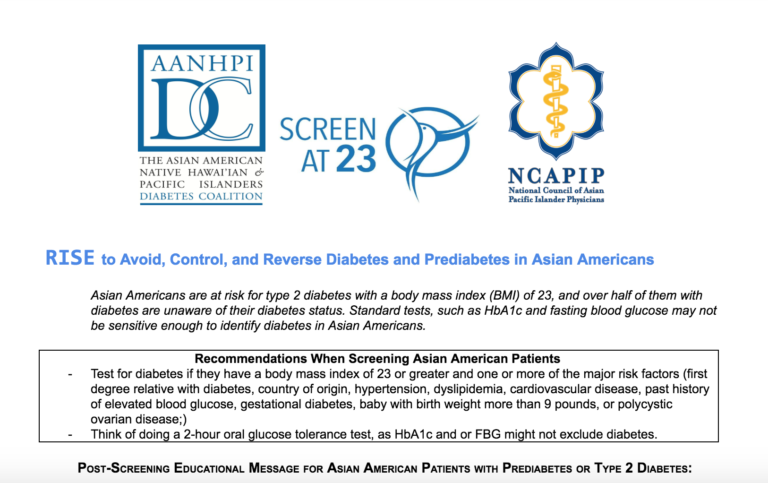
If you've been diagnosed with type 2 diabetes or prediabetes, it's time to RISE.
RISE and Seven Steps Handout
RISE Slides (pdf)
RISE (Reduce, Increase, Sleep, and Exercise) takes scientific evidence based recommendations from The Diabetes Reset written by Dr. George King of Harvard's Joslin Diabetes Center and turns them into seven steps. These recommendations, about diet, exercise, stress reduction, and other actions, can be followed by anyone but are targeted towards Asian Americans.
Take The Prediabetes Risk Test With A Doctor In A Couple Of Minutes
Watch here in English
Watch here in Vietnamese
Watch here in Cantonese

